Five months ago, 25 emails were sent by someone named ‘Jacqui Bullivant’. Originating from a mailing list set up by Jessie Bullivant, they each had the same function: “to excuse Jessie Bullivant from presenting a Public Programme at the Kuvan Kevät exhibition today.” The latter is an annual MFA degree show by the Academy of Fine Arts in Helsinki. As with most art schools, the production of the exhibition resembles a parent trying to cheer up their sulky child with an overblown birthday party. Forced to perform as a happy participant at a function you despise aptly depicts the mood for the Helsinki-based artist’s online (inbox) work ‘To Be Announced. With Special Guests. Refreshments Provided. Subject To Change.’, which debuted during Kuvan Kevät’s month-long program. It was physically present in the show only as an iPad allowing you to sign up for the mailing list, and is currently on display as part of the Wormhole exhibition, curated by Bullivant and running from November 22 to December8, at Sydney’s Knulp.
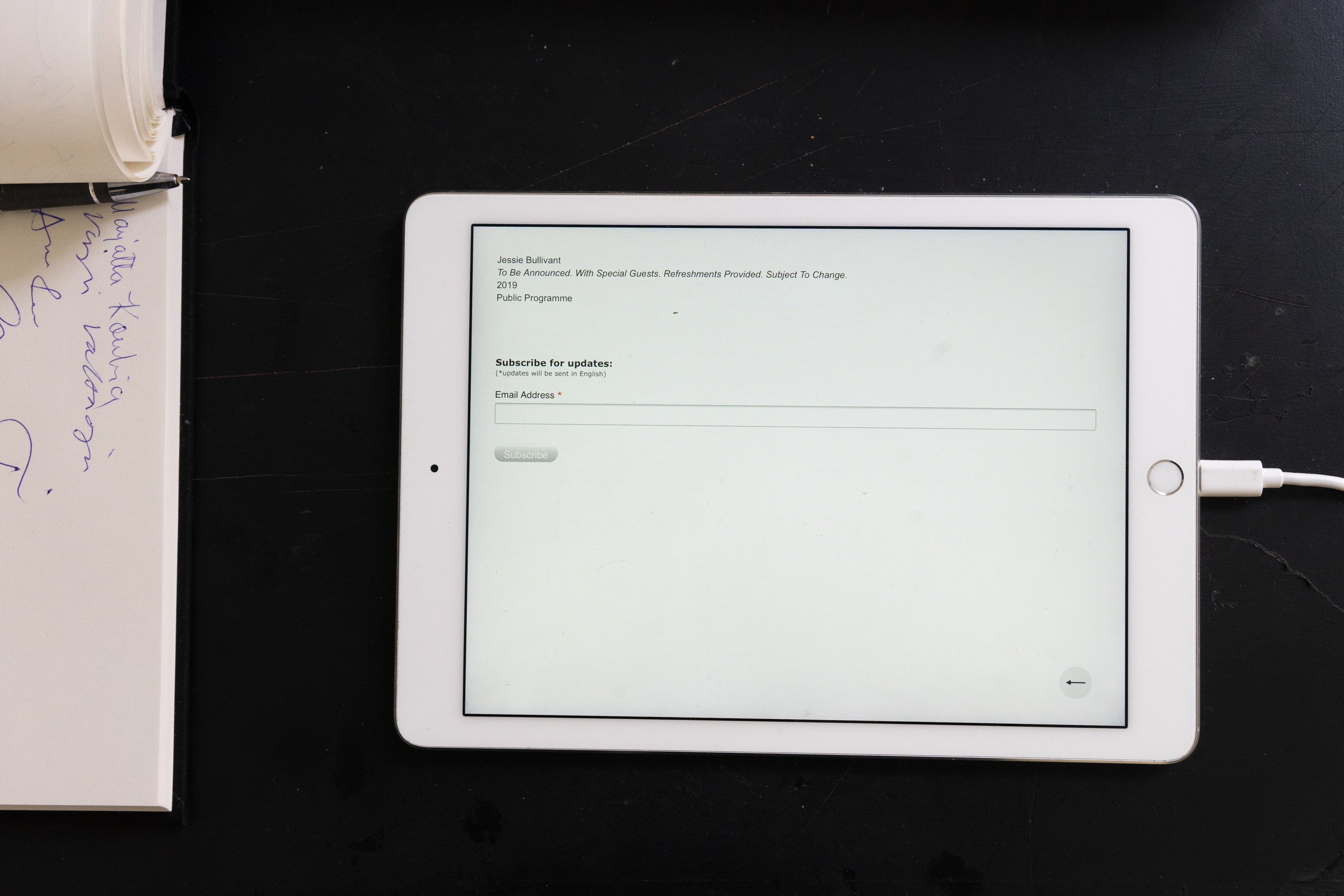
Jacqui is presented as Jessie’s mother. Some of her pleas for her daughter’s absence amount to little more than hurried excuses decorated with pep talk. Jacqui offers a host of reasons she wants her daughter to skip the exhibition but both the institution and parent are incapable of understanding the root cause of the problem with Jessie. Nothing seems to bolster the daughter and mom is forced to send a letter of explanation every day of Kuvan Kevät. “We are seeking professional advice, but despite our best efforts, we don’t yet have a diagnosis,” Jacqui informs us on May 7. The messages are vehemently parental. Nothing screams ‘mom email’ more than “sent from my iPad”, stated below the signature, which contains the word ‘mother’ in parentheses, like an afterthought. The curved marks signal something else, too—Jacqui might not be fully committed to helping and is sending the emails only because she has to, in her role as the young artist’s mother. The ambiguity spills out between the lines. “Jessie cannot participate today as they’ve been attempting to change. This has, at times, been in conflict with other obligations. It would have been easier to stay the same. But I can assure you that this was not an option,” Jaqui explains. After almost two weeks of emails, the artist-cum-daughter is starting to seem insufferable.
As the daily emails pile up, you sense how Jacqui begins to enjoy her role as the sole performer of the artwork. She’s the only one who’s present, after all. It figures some of the messages gallop off-track, with Jacqui lost in personal reflections, much like an artist who thinks everything she has experienced must be shared with others, for she is special. One email at a time, the dynamic of an artist making work about their parent is turned upside down. Or is it symptomatic of the relationship? What if the child is unable to perform because their parent has always stolen the spotlight? The iPad for signing up for the daily emails is listed in the exhibitions notes as ‘Public Programme’. This title is key to understanding Bullivant’s work. The perpetual task of visibility and the putting on of a show connects parental approval with art school standards. The idea of sticking to the program might come more naturally to Jacqui, who as a mother probably has more of a knack for organizing things, whereas the daughter-cum-artist freezes in their tracks when responsibility calls.
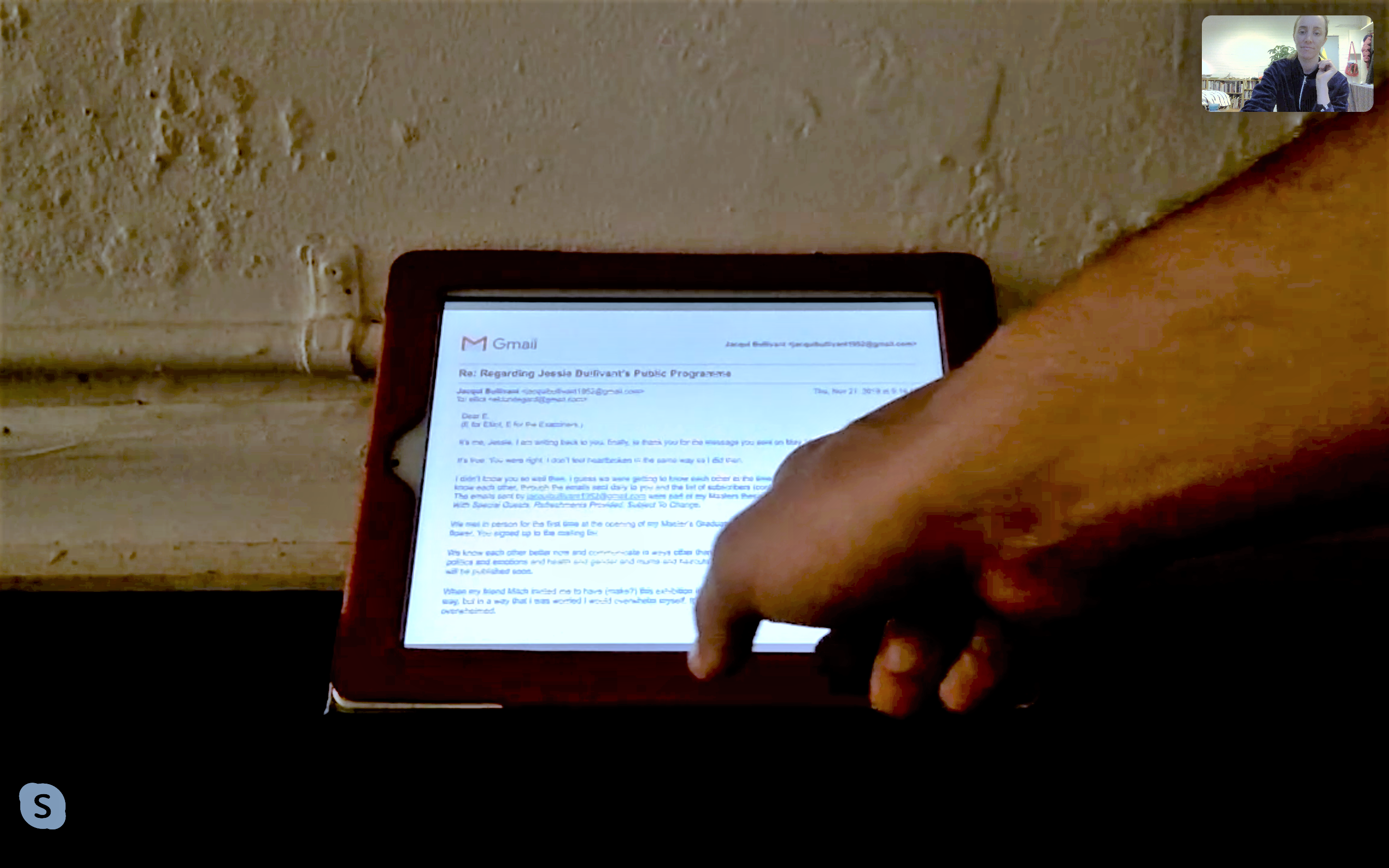
At times, the writing has more literary ambition, reminiscent of Natalia Ginzburg’s novel Happiness, as Such, in which an Italian dysfunctional mother testifies to the disintegration of her family by exchanging bitter letters with her son and his lover. Much like with Ginzburg’s characters, you realize early on that nothing good will come of the fictional Bullivant family, and the real drama unfolds in seeing how far removed the mother is becoming from her child. On May 19, at 9 am sharp, Jacqui emails a more personal message:
“We were all very proud of her. Even the Catholics in the family were fine with it (however, I didn’t tell my brother-in-law because I don’t know how he would feel about his niece being a lesbian). I did some reading online about marriage in Finland and found out that its intended purpose is the establishment of a family for the common good of its members and the preservation of society. Which is true in their case, to an extent, because it would have helped her girlfriend to access some of the same privileges as her. Of course, she was also doing it for love. By the power vested in me, Jacqui Bullivant[.]”
In the message, other people are implied for the first time but they’re not brought to the fore. They keep their places as set design, or emotional scenery, through which the parent and the child can lash out. The familial drama rambles even if the backdrop is changed by invisible stage hands, also known as life events such as divorces and marriages, or births and passings.
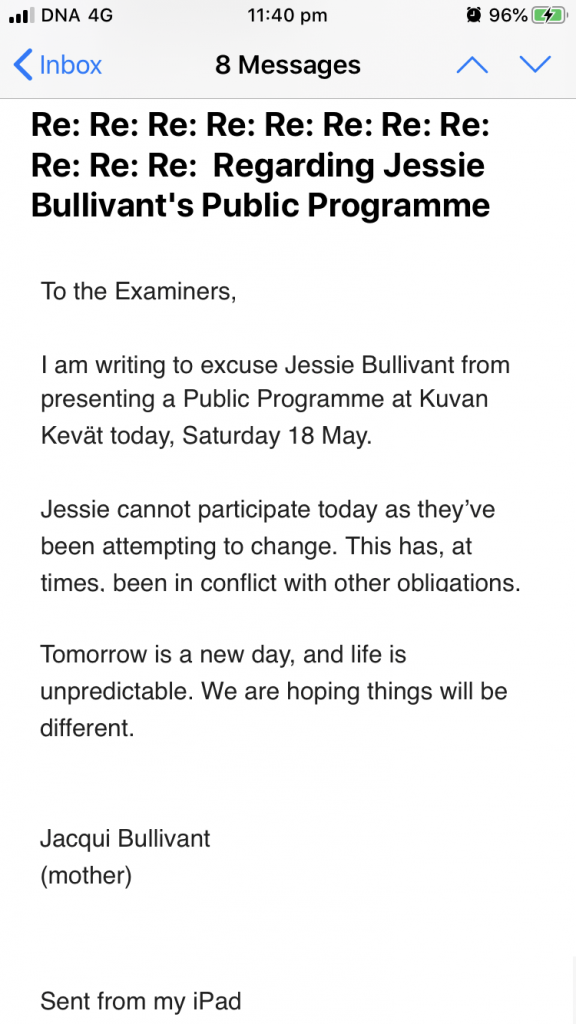
What rings true for families also does for art institutions. People are fired, and a new organizational structure is rolled out whenever a rector feels the need to leave their mark. Whatever change may take place on the surface, the calamitous dynamic lives on underneath the endless rounds of musical chairs, or because of them. Do institutions exist solely for the sake of tiring interpersonal drama? Or could it be that this drama, which is usually labeled as a side effect, is the real raison d’être for the bulk of our social constellations? Would you even call it an art school, or family, if you’d like to be there? There’s more to Bullivant’s piece than institutional critique, though. The real impact of the work is delivered in Jessie’s— the actual artist, not the proxy daughter— style of writing, which is a combination of irony preserved in a dark place like cured ham, and niceties as sickly sweet as a birthday cake. Their prose makes the mother sound like she has had a hurried diet of Foucault, poured a glass of merlot one too many, and let her iPad’s Mail app suffer the repercussions. The mother is the Ghost of the Middle Aged Artist Yet to Come.
While reading Jacqui’s paltry thoughts, one can imagine the Finnish art academy’s teachers on the receiving end mirroring those sour remarks, especially because the messages could have originated from the institution’s end. The art school staff used to have high hopes for the young prodigy, before they saw too much failure, and so they became embittered. Seen this way, the mother is inseparable from the institution, and as I mentioned earlier, from the role of an artist, too. All three are one. When reading Jacqui’s mockery of her matrimonial role, we notice her having an acute understanding of the situation that binds them. Mothers need to produce daughters who produce works about their mothers for institutions that exist for mothers to have a place for their daughters.
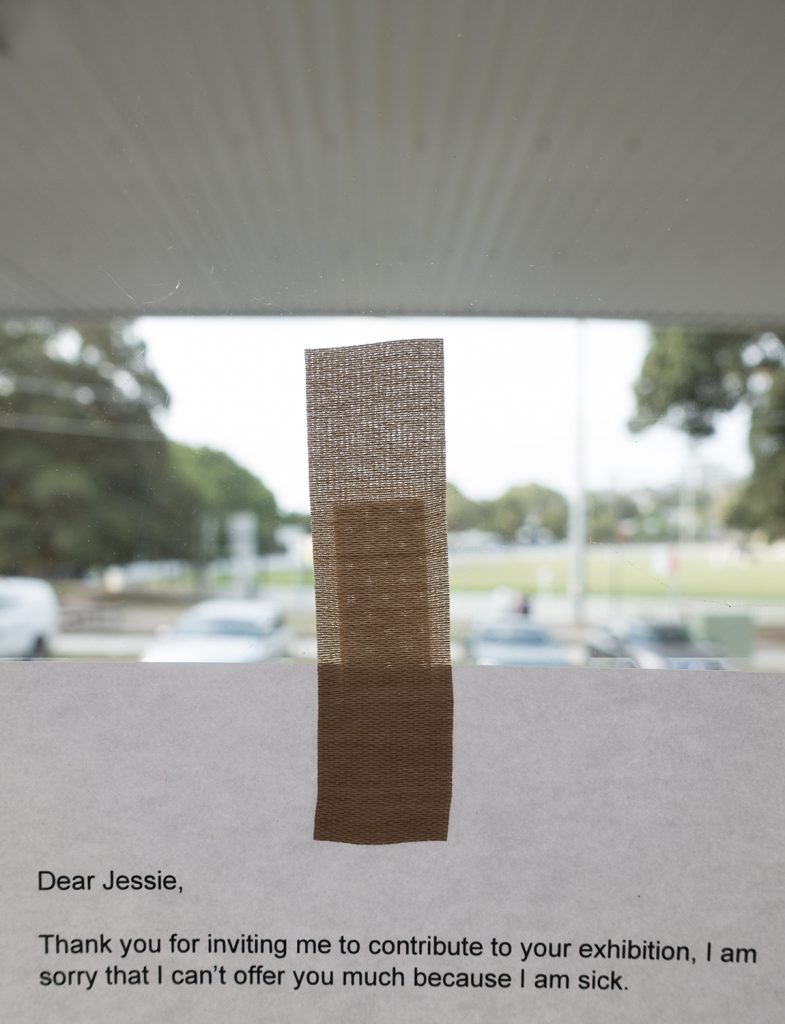
As the audience, we are unable to tell reality from fiction, which is why we shouldn’t look at the emails as proof or confession by Bullivant, but as a case study. Everything we learn about other people comes to us in this form, anyway: as barely muted disdain sold to us as neutral information. Accepting this about fiction, we can move from rooting for one character to contemplating the full picture, allowing us to see something universal in the particularities of a narrative. Fiction often doubles as therapy (especially in this economy). One day, when faced with familial drama in our own lived narratives, we can take comfort in our situation’s general nature. To fail your parent or institutions is nothing unusual.
In some of the emails, the mockery falls flat. “We have been trying different remedial therapies, but it seems futile unless we can locate the cause. It has become apparent that it may have originated inside the institution.” Such declarative passages seem a little on the nose and feel like a given. An art student is expected to take a Holzerian shot at the hand that feeds. It allows for the spectator to smugly nod along with the joke and chuckle at the trappings of art schools. But it may also distance one from the flow of the work, returning it to the familiar terrain of in-group irony. Institutional commentary connects the work to the genealogies of contemporary art, giving a wink to the reader in the know. It risks flattening Bullivant’s substantial analysis on the similarities between the three parties at play. Such moments being rare, the work remains strong enough to stomach the disparities.
The academy and the mother are both impossible to reconcile. The school keeps on wanting things Jessie (the fictional MFA artist) doesn’t want to or know how to give, and the mother feels perpetually disappointed by her child’s inability to follow through. Their shared need to control how Jessie behaves in public renders the artistic practice impossible. Nobody in the situation is enjoying themselves, as Jacqui scathingly points out; neither the readers who are irritated with the daily emails, the people working at the academy, the mother, or the artist.
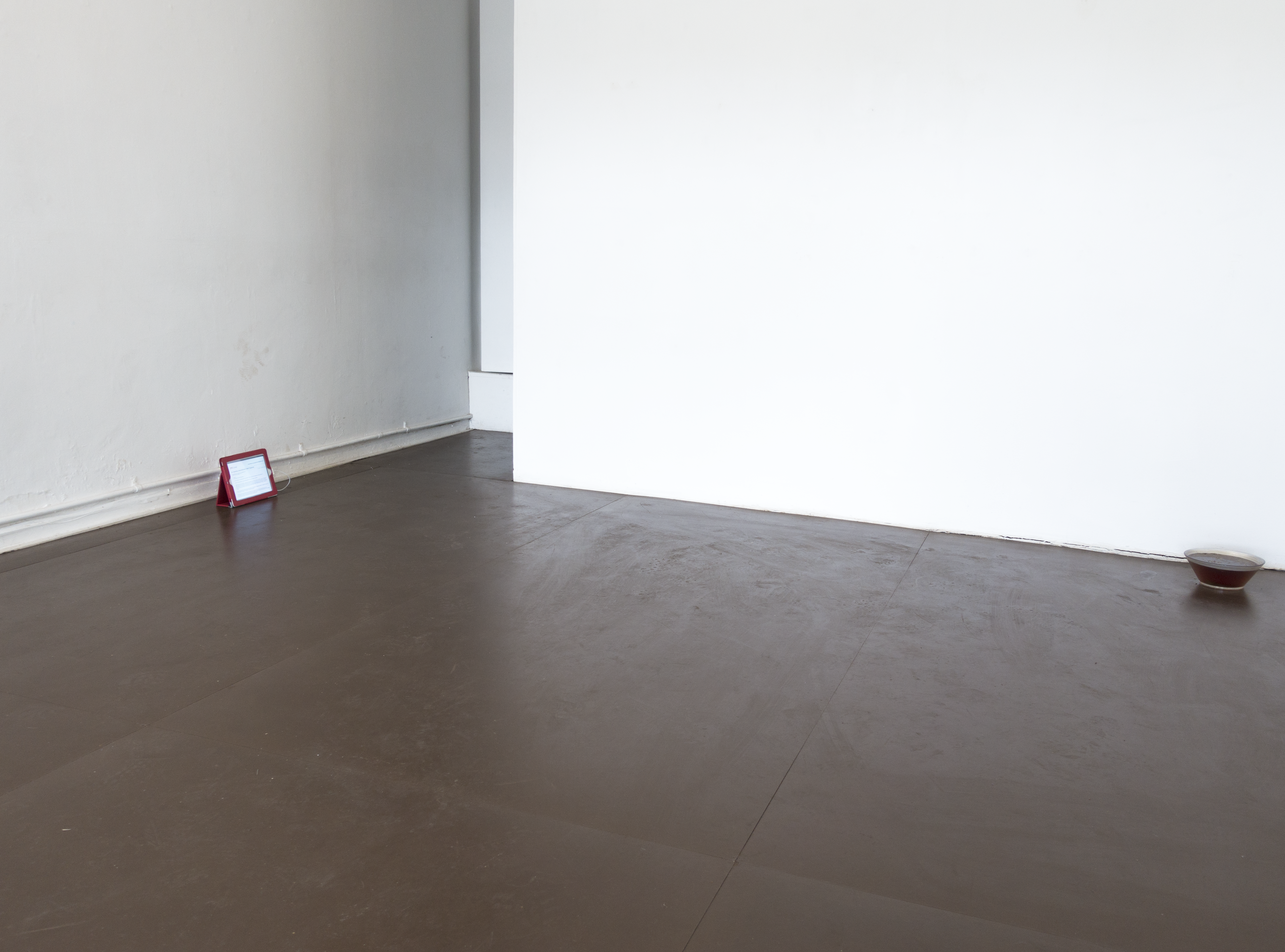
“She needs the MFA qualification for her CV. But she’s been trying not to see it as a means to an end. It’s a trap we can fall into if we’re not careful. Personally, I get pleasure from spending time in the garden and caring for my animals. It’s starting to get cold here. This morning I chopped firewood, and there was a beautiful sunset last night”, Jacqui explains, on May 26. There’s more to life than art school, she appears to be saying. But the alternative she presents sounds quaint. The imperious delivery feels like someone watching you from the confines of their mansion; you might be invited up there for a birthday party, provided you can behave. The physical task of chopping wood represents a performance in an idealized rustic lifestyle. It’s contrasted with the abstract, often mind-boggling job of a contemporary artist. You don’t need an MFA to tend to animals. Perhaps, we’d all be happier in a farm. Graduation provides one of those sobering moments where you’re prone to ask yourself: who asked for this? **
Jessie Bullivant & Special Guest’s Wormhole solo exhibition is on at Sydney’s Knulp, running November 22 to December 8, 2019.













